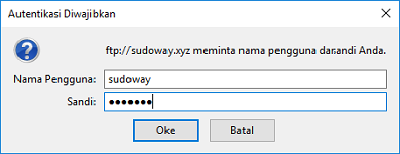

# systemctl status rvice Step 5: Access the vsftpd server Rsa_private_key_file=/etc/ssl/private/vsftpd.pemįor the changes to come into effect, restart the server. Rsa_cert_file=/etc/ssl/private/vsftpd.pem In summary, your configuration file should contain these lines: listen=NO Rsa_private_key_file=/etc/ssl/private/vsftpd-key.pem rsa_cert_file=/etc/ssl/private/vsftpd-cert.pem Head back to the default configuration file /etc/nf, and paste these lines to specify the path of the generated SSL certificates and enable SSL. # openssl req -x509 -nodes -days 365 -newkey rsa:2048 -keyout /etc/ssl/private/vsftpd-key.pem -out /etc/ssl/private/vsftpd-cert.pem We are going to generate a self-signed SSL certificate to encrypt the server. To provide a secure FTP connection to the server, we need to encrypt the server using an SSL certificate. write_enable=YESĪdditionally, you can limit the local users who can access and upload files by specifying only the users contained in the /etc/erlist file. Next, you need to allow the local user to upload files and gain access to their home directory as well as make changes to the files as indicated. Therefore, we will disable login by the anonymous user and only grant access to the local user. But this is not what we want due to security purposes. Now we must proceed and edit the main configuration file /etc/nf # nano /etc/nfīy default, anonymous users are granted access. # chown -R unixcop-user: /home/unixcop-user/ftp-dir Step 5: Configure vsftpd service # chmod -R 750 /home/unixcop-user/ftp-dir Now, create an FTP directory for the FTP user and assign the appropriate directory permissions and ownership.

# echo unixcop-user > /etc/erlist Step 4: Create FTP user directory Local users specified in this file are granted permission to access the FTP server. Now, we will add the FTP user to the erlist file. # adduser unixcop-user Step 3: Add FTP user to the list of allowed login users

use the adduser command followed by the name of the user and respond to the prompts accordingly. Next, we are going to create a unique FTP user account that we are going to use to log in to the FTP server. You can confirm this by running the command: # systemctl status rvice Step 2: Create a FTP user Once installed, vsftpd starts automatically.
#DEBIAN INSTALL FTP UPDATE#
Step 1: Install vsftpd packageįirstly, update the package list and upgrade your Debian server. In this tutorial, we’ll install vsftpd FTP server on Debian 11. VSFTPD ( Very Secure FTP Daemon ) is a fast, secure and stable FTP server that uses encryption to secure data exchanged with the server. However, it is fraught with security risks since it sends data and sensitive information in plain text. This guide explains how you can set up such an FTP server using Debian (including TLS encryption).FTP or File Transfer Protocol, is a popular protocol for transferring files to and from an FTP server. Of course, as a self-host you can also use the file transfer technology by installing and configuring your own server.

#DEBIAN INSTALL FTP SOFTWARE#
Since you only need to access the FTP server with a client software this way, and a networking of both components via the internet is sufficient, the transfer technology is often used for uploading and downloading files to and from web spaces.Īs a tenant of such website resources, you usually receive specific log-in data that can be used to connect to the hosting provider’s FTP server. In addition to transporting data via TCP ports 20 and 21, the transmission protocol for IP networks acting on the application layer also offers the options to create directories and structure them as required. Among the possible solutions, file transfer via the File Transfer Protocol (FTP) is still one of the most sought-after today. If you want to regularly store and retrieve larger files from a server, then you need suitable transmission technology.


 0 kommentar(er)
0 kommentar(er)
